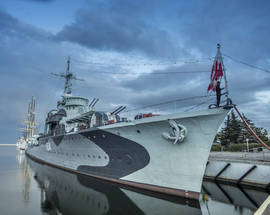ORP 'Błyskawica' Warship
Both boats were spirited to England on the eve of war as part of the Peking Plan, and from there on the Polish craft came under the command of the British Royal Navy. Based in Cowes the Błyskawica saw action several times, including in the Mediterranean, Normandy and as an Atlantic convoy escort. However, her finest moment was to come in Cowes. Captained by Wojciech Francki, it was on the night of the 4th May 1942 that the British town came under attack from up to 160 Luftwaffe bombers. Anticipating an attack Capt. Francki had sneakily ensured the Błyskawica was well-armed, despite a ruling stating the vessel should have been decommissioned while in port. In a further breach of regulations Francki ordered his crew to fight off the waves of bombers, and what followed was a ferocious battle between sea and air - such was the rate the boats guns were firing the crew were compelled to continually douse them with seawater in a bid to cool them. The heroic defence and the smokescreen that was lit was enough to thwart the Luftwaffe, and the captain and crew were hailed as the ‘saviours of Cowes’. Less forthcoming in their recognition were the pedants in the British Admiralty; conscious of condoning a blatant violation of the rules they sent a tight-lipped dispatch commending the good work done by Francki.
At the end of the war the Błyskawica returned to Poland, though without its captain and many of its crew. Francki chose a new life in Australia, away from the suspicions and hostility of the new communist government, and it was a lead followed by many of his servicemen. In 2004 the actions of the Błyskawica were formally acknowledged, and a plaque unveiled in the port of Cowes by Francki’s daughter. The ship itself was retired from service in 1969, and has since served as a museum ship held in the sort of regard the Brits reserve for the HMS Victory. It’s the only ship to be awarded Poland’s highest military decoration, the Gold Cross of the Virtuti Militari Order, and other points of interest include a three-barrelled torpedo launcher, a torpedo cross section, scale models, weapons and uniforms.
The ship is open to the public as a seasonal museum and branch of the Gdynia Naval Museum from May 1.
Open
Closed Nov-March. Last entrance 45mins before closing.







Comments
Arames
Its destroyer, not battleship